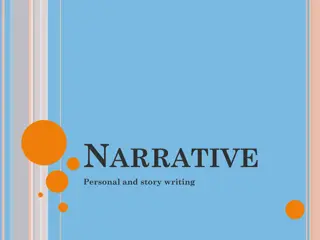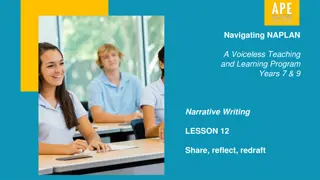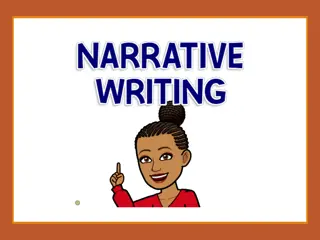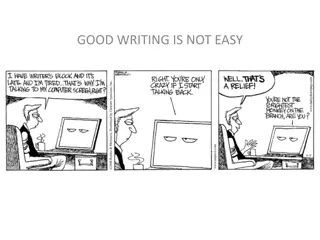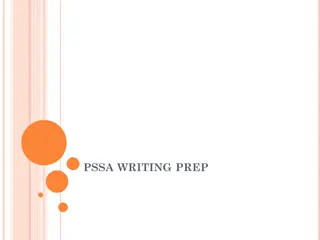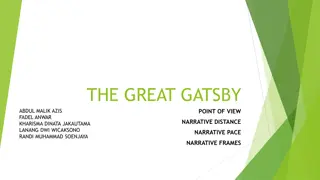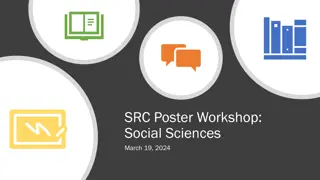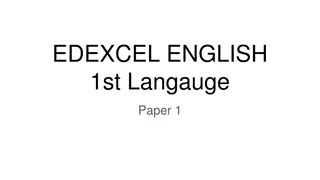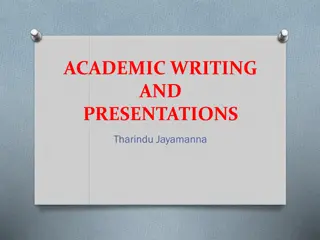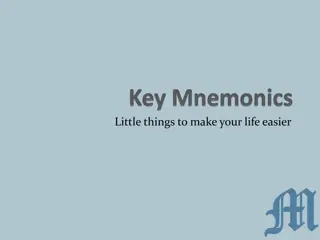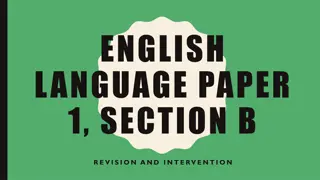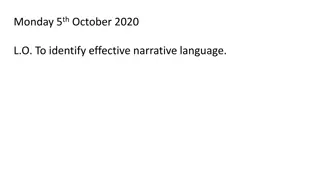Mastering Narrative Writing: Tips for Year Levels 3-6
Dive into the art of narrative writing focusing on Year Levels 3 to 6. Explore the importance of narratives in children's lives, the inclusion of narrative in the Australian Curriculum, understanding what truly constitutes a story, and engaging activities to spark creativity in students.
Download Presentation

Please find below an Image/Link to download the presentation.
The content on the website is provided AS IS for your information and personal use only. It may not be sold, licensed, or shared on other websites without obtaining consent from the author. Download presentation by click this link. If you encounter any issues during the download, it is possible that the publisher has removed the file from their server.
E N D
Presentation Transcript
Teaching the Art of Narrative Writing Year levels: 3, 4, 5 & 6 Ziptales Webinar Number 3
The Importance of Narrative Stories are central to people s lives. Children love narrative. We need to teach children how to construct narratives. But teaching how to structure a story can be difficult.
Narrative in the Australian Curriculum The new Australian Curriculum mandates narrative. For example: Discuss how authors make stories exciting, moving and absorbing and hold readers' interest by using various techniques character development and plot tension Create literary texts by developing storylines, characters and settings The NAPLAN test includes, as an option, a narrative writing piece. This seminar explores: o o o o o o o What is a story? The problem situation Character and motivation What happens next ? The importance of plot Is genre important? A writer s toolkit Five ways to kill a story stone dead
What is a story? Ernest Hemingway s six word story: For sale: baby shoes, never worn. More modern examples: Crook outruns cops. Walkie-talkies outrun crook. Penniless man. Won lotto. Overnight genius. Man cries, holding his dog s leash.
What is a story? What is a story? The king died and then the queen died. is not a story. It is just two events. A modern equivalent: I went to the office on Monday. I went on Tuesday. I went on Wednesday. I went on Thursday. On Friday I was sick. On Saturday I rested. On Sunday I felt better. This too is nota story.
What is a story? However The king died and then the queen died of grief. is a story. There is a causal connection. The first event - the death of the king is the causeof the queen s death. There is an argument a problem leading to some sort of development and finally to a resolution. E.M.Forster Aspects of the Novel (1927)
What is a story? Here is a very short example from a child: One day I found a very strange egg. I put the egg in my pocket and took it home. I kept it warm for twelve days. Finally it cracked and a green wing appeared, followed by a green tail, and lastly out popped Oh no! A dragon . (Toby Fotheringham) Suggested activities boy who sees into the future; girl who can t lie, etc. Try What if ? exercises: What if you could read people s thoughts? What if a strange cousin came to live? What if you got lost in a strange city? etc Take famous fairy tales and work out what happens that makes them stories. Make up a story - create the outline of a story from simple words or ideas:
The problem situation: the seed of narrative Stephen King: I find a situation that is a problem and develop it. Example: A girl is tormented by school bullies. She has special powers. She revenges herself on her tormentors using her powers. This is the basis of Carrie. It launched the then unknown US school teacher into a writing career spanning 40 years.
The problem situation: the seed of narrative J K Rowling: o o o there is a boy wizard named Harry he goes to school (Hogwarts) he is the orphan son of wizards who had been killed off by Voldemort Voldemort is coming after Harry Potter o
What is the key to narrative? The protagonist (the central character) is in personal jeopardy. Examples: o Snow White finds herself in the woods with a man who has been ordered to kill her and cut out her heart. o James Bond has to avoid being killed in some very unpleasant way. o Sometimes it s the whole world that is in jeopardy. There is a problem, usually caused by some turmoil within the home. A woodsman marries a second wife who wants his children dead, a young girl s father remarries and the new wife brings wicked stepsisters into her life, a mermaid falls in love with a prince (Carolyn Wheat, How to write killer fiction) Danger and threat whether physical or psychological is essential to most stories.
What is the key to narrative? Sometimes the situation is a need or goal that must be satisfied. Example: Kate finds a key in her Mum s jewellery box. She tries all the doors in her house, but the key doesn t fit. She goes to the garden. Behind a bush is a door. The key fits and she goes through into (Dione Mitchell) Kate s curiosity is the key ingredient. What does the key fit? She needs to know. That is her goal.
What is the key to narrative? Other examples Wrong number, says a familiar voice. When he woke up, the dinosaur was still there. Last man on Earth. There is a knock at the door. Suggested activities o As a class, talk about the basic idea of famous films and stories. o Talk about odd situations eg Being locked out of the house; A stranger appears; You accept a stupid dare. Talk about how you could develop a story out of that situation. o Use these words as a starting point for a story: Revenge; Escape; Rescue; Temptation; Underdog; Lost. If someone has a problem, or a goal to reach, they must act. This causes them to go on a narrative journey - the story.
Character and motivation All stories have characters. Why? Stories: how people act in response to a problem or goal. Kate what is key for? Kate needs to find out Kate s motivation is curiosity. Carrie bullied Wants revenge Carrie s motivation is pain. Characters have goals. Kate Carrie wants wants to find out (her goal) revenge (her goal)
What is the key to narrative? Characters should be like real people. Everything must be true to the character. Suggested activities o o Kate is a sweet little girl. Carrie is a troubled teenager. o In groups, talk about what we would expect if these characters appeared in a story: The Prince in Cinderella; Shrek; Harry Potter. o Design a character (Part A). You might create a young boy who is always up for something dangerous to do; or a girl who is unhappy because she is lonely; or a fantasy character such as a fairy or a princess. o Design a character (Part B). Now take the character created (Part A) and imagine a problem situation, something that that character has to respond to. The actions, the plot - must align with the character. o o If Kate decided to take revenge? If Carrie wanted to explore a fantasy garden?
What happens next? The importance of plot A character reacts to the problem situation. Example: Plot = (1) Billy and Harry go to Santorini and dive (2) they see Atlantis - this a wonderful thing, but (3) a Kraken appears (it is a perilous situation) (4) they escape in the machine, but (5) a giant whale appears and endangers them, so (6) they escape, but (7) an earthquake begins, so (8) they teleport back home - safe and sound. Dr Wow in Atlantis Characters = Billy, his crazy inventor Uncle Harry Provocative situation = Harry invents a submarine to explore the lost city of Atlantis
Plot Climax 3 Climax 2 Earthquake Climax 1 Climax Whale Anticlimax Anticlimax Kraken Complication Anticlimax Complication Return home Santorini Complication Lab Beginning of action Resolution Exposition
What happens next? The importance of plot Authors deliberatelycreate problems for their characters. Climax 3 Climax 2 Climax 1 Climax Anticlimax Complication Complication Complication Beginning of action Exposition Resolution
What happens next? The importance of plot Dione and the key to the mysterious door. Climax 3 A wicked wizard appears The key is lost Climax 2 The wizard is defeated with the magic key Climax 1 Climax It is ruled by an evil witch Anticlimax Complication Complication Dione arrives in the magical land beyond the door Dione goes home Anticlimax Complication The key is found Dione defeats the witch Anticlimax Beginning of action Exposition Resolution
Stories are always structured Even in intimate human interest, or emotional, stories, there is a definite shape to the narrative problem, development, and finally resolution.
The seven basic plots Christopher Booker claimed there were a total of just seven basic plots: Overcoming the Monster Hero learns of a great evil, and sets out to destroy it. Eg Perseus and Medusa, James Bond, Star Wars Rags to Riches Hero gains wealth and success. Eg Cinderella, Aladdin The Quest Hero learns of a magical object or wonderful place - and sets out to get there. Eg The Wizard of Oz, Lord of the Rings Voyage and Return Hero goes to a strange land and, after overcoming the threats, returns. Eg Alice in Wonderland, Peter Rabbit, The Time Machine and so on. The other plots are: Comedy, Tragedy and Rebirth. (Christopher Booker, The Seven Basic Plots)
The twenty master plots Ronald Tobias, in Twenty Master Plots: 1 Quest eg Raiders of the Lost Ark 2 Adventure eg Treasure Island 3 Pursuit eg The Fugitive 4 Rescue eg The Princess Bride, ET 5 Escape eg The Rats of NIMH 6 Revenge eg The Incredibles 7 The Riddle eg almost all whodunnits or mysteries 8 Rivalry eg Snow White and the Seven Dwarfs 9 Underdog eg Cinderella, Ratatouille 10 Temptation eg The Lion, the Witch and the Wardrobe 11 Metamorphosis eg Beauty and the Beast 12 Transformation eg My Fair Lady 13 Maturation eg Tom s Midnight Garden 14 Love eg Tangled, Enchanted 15 Forbidden Love eg Romeo and Juliet 16 Sacrifice eg The Happy Prince 17 Discovery eg The Hobbit 18 Wretched Excess eg The Dark is Rising 19 Ascension eg Harry Potter 20 Descension eg Dracula Suggested activities o Task 1: Make a selection from the two lists of story plots choose 12 story plot types. Then as a class or in groups find examples of each. o Task 2: (a) Find another example, and (b) write a simple outline of an original story using that plot type. o Find a Ziptales story and pull its plot to bits - as for Dr Wow in Atlantis .
Is genre important? Children see that there are different types of stories. (Genre = French for type) o o o o o o o A fairy tale or fantasy has magical characters and lots of wonders. A mystery story has clues and investigates possible suspects. A comedy story has misunderstandings, confusion, embarrassing surprises etc. A scary story has a terrifying threat of some kind. An adventure story has lots of action and danger. A myth has a hero on a dangerous quest. A people or relationship story is about people resolving their issues satisfactorily. Suggested activities o Source one story from Ziptales. (1) Read the story, and (2) strip it down to its basic lines. What makes it work? What other stories are like this? Then children create their own stories in each genre type. o Study popular films eg Frozen, Toy Story, etc what genre (and why)? o Have children make up the plot line of a story in each major genre: one group creates a mystery story, one a scary story, one a fairy tale, etc.
A writers toolkit Subway hero o Drama - all stories thrive on conflict. Beauty and the Beast o Dialogue - the words spoken by the characters bring the situation to life. Dialogue is vital. o Detail - Detail brings a story to life. Dr Wow Suggested activities o Imagine a situation at school where two people are in conflict over something. How could this give rise to a story? o Take that situation, and work out what they could say. o Take a setting from the earlier activity on plot and build up all the details to make it come to life.
Five ways to kill a story stone dead o o Don t set boring topics eg How I spent my summer holidays. Don t say Only write about what you know! or Only write about real life! It s more important to encourage children s imagination. Don t say: just write whatever comes to mind. Don t say use lots of big words. Narrative writing is not linguistic dress up . Don t insist on a moral. o o o Suggested activities o Share with the children the stories you really liked as a child, and explain why. o Brainstorm great ideas for a story (in whatever genre) and let children fill in the details. o Encourage imagination and invention. Even if the story is not perfect, it s extending them mentally.
Webinar 3 Thankyou for joining us for this online webinar on Teaching Narrative Writing. This session represents 30 minutes of Professional Development. A certificate will be emailed to you following the successful completion of the session. We wish you and your students all the very best for all their narrative writing!


